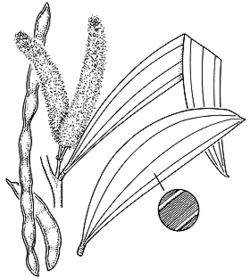Common name: Bulga wattle
Acacia bulgaensis Tindale & S.J.Davies APNI* Synonyms: Racosperma bulgaense (Tindale & S.J.Davies) Pedley APNI*

Description: Shrub or small tree to 6 m high or sometimes taller; bark flaky to fibrous, grey-brown; branchlets not markedly triquetrous, becoming terete, glabrous, often pruinose.
Phyllodes dimorphic, mostly narrowly elliptic, subfalcate, 3.5–10 cm long, 7–23 mm wide, often glaucous, glabrous, longitudinal veins numerous, closely spaced, non-anastomosing, usually 3 more prominent, (3-) 4–7 (-8) veins per mm, apex acute with a mucro; inconspicuous basal gland to 3 mm above pulvinus; pulvinus 1.5–3 mm long; phyllodes on young growth shorter and broader, ± elliptic and straight.
Inflorescences 1 or 2 on a short axillary axis; peduncles 2–6.5 mm long, glabrous; heads cylindrical, 3–5.2 cm long, bright yellow.
Pods straight, curved or slightly twisted, ± flat except over seeds, barely to slightly or occasionally more deeply constricted between seeds, 2–9.5 cm long, 3–5 mm wide, firmly papery to thinly leathery, ± smooth or with a few fine veins, glabrous, often slightly pruinose; seeds longitudinal; funicle folded 2–4 times and scarcely expanded into a small aril.
Flowering: September–March.
Distribution and occurrence: restricted to the Bulga-Milbrodale-Broke area; rare. Grows in sclerophyll woodland/forest, on sandstone or shale.
NSW subdivisions: NC
Named after Bulga, the main settlement in the area where A. bulgaensis occurs.
Text by P.G. Kodela (last updated May 2012)
Taxon concept: P.G. Kodela & G.J. Harden, Flora of NSW Vol. 2 (2002)
APNI* Provides a link to the Australian Plant Name Index (hosted by the Australian National Botanic Gardens) for comprehensive bibliographic data
***The AVH map option provides a detailed interactive Australia wide distribution map drawn from collections held by all major Australian herbaria participating in the Australian Virtual Herbarium project.
|


